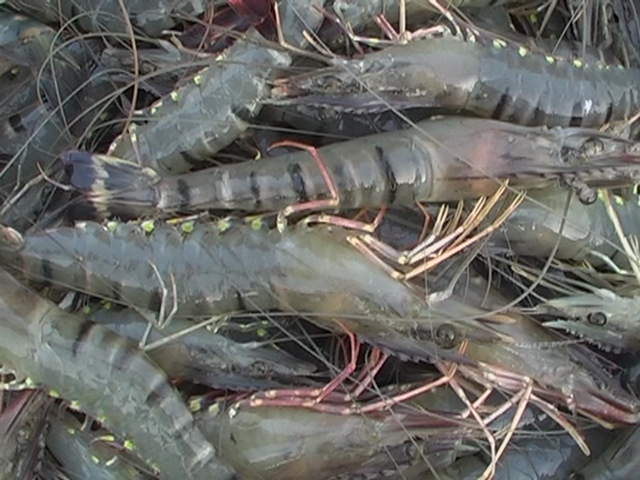- In one era, shrimp exports decreased by 52pc
- 2 lakh hectares out of 2.5 lakh suitable for shrimp farming
- 7K acres land suitable for farming is uncultivated in Cox’s Dist
- Per hectare 8000 kg venami shrimps are produced, whereas bagda 600-800 kg
The quantity of frozen shrimp exports from the country is decreasing continuously. Even a decade ago, 50,000 tons of shrimps were exported annually from Bangladesh in the world market. But it has come down to less than half in the last financial year. The amount of which is about 24 thousand tons.
During the same period, the export earnings from frozen shrimp decreased from $57 crore to about $24 crore. Although the demand of shrimp in the global market is gradually decreasing, the export target was reduced at the beginning of the financial year ended. But still that target was not achieved at the end of the financial year. Bangladesh Frozen Foods Exporters Association (BFFEA) and Export Development Bureau (EPB) related sources know this information.
According to related sources, Bangladeshi entrepreneurs became interested in exporting the product about two decades ago due to the demand of frozen shrimp in the global market. At that time, shrimp processing factories were established in different parts of the country. But due to the economic recession after 2008, the price of frozen shrimps decreased. Along with this, the demand for Venami shrimps is increasing in the world market and the demand for bagda or lobsters produced in the country is starting to decrease. Mainly due to non-starting of production and marketing of Venami shrimp, reduction of cultivation land and shortage of raw materials, shrimp export in the world market is decreasing. In view of that, many shrimp processing factories have already been closed.
According to sources, about 50 thousand tons of shrimp were exported in the last financial year 2012-13. The market value of which was approximately 57 million dollars. And in the fiscal year 2023-24, only 24 thousand tons were exported, which is about 24 million dollars in financial terms. In the span of one era, shrimp exports have decreased by about 27 thousand tons or 52 percent.
Financial figures which amount to 330 million dollars or 57 percent. Frozen shrimp exports have consistently declined every year over the past decade. However, in the fiscal year 2022-23, shrimp exports are targeted at around $500 million. But at the end of the fiscal year, only $300 million worth of shrimp can be exported. And in the fiscal year 2023-24, the target is set at $29.79 crore.
At the end of the year it came down to only $24 crore. That is to say, even though the shrimp export target was reduced by 40 percent during the year, it was not possible to export that amount of shrimp. Sources also said that the target of shrimp export in the last five years was $36.10 crore, $41.50 crore, $33 crore, $50 crore and $29.79 crore in the financial year 2023-24.
And in the last one period only in the fiscal year 2021-22 it has been possible to export more shrimp than the target. At that time, despite the target of $33 crore, 30 thousand 571 tons of shrimp were exported for $40 crore 72 lakh 50 thousand.
Mainly due to reduced supply of shrimp in the global market during the Covid pandemic and increase in prices, the exports were higher than the target. Meanwhile, frozen shrimp exporters say that due to the decline in frozen shrimp exports, traders' backs are against the wall. Every year, the demand of the world market increases, but the businessmen of this country are losing the market due to the lack of production of Venami shrimp in Bangladesh. Processing plants have closed due to lack of raw materials. Many have even sold factories. Bagda shrimp is cultivated in 2 lakh hectares out of about two and a half lakh hectares of land suitable for shrimp cultivation in the country. Moreover, seven thousand acres of land suitable for shrimp farming is lying uncultivated in Chakaria-Rampura mouza of Cox's Bazar district under the jurisdiction of the Directorate of Fisheries. If this area is declared as a shrimp farming zone, it will be possible to supply 80 percent of the raw materials needed by the processing factories from here. Large-scale shrimp production is possible in the shrimp area in Chakaria-Rampura area. At present, the number of companies involved in the frozen fish export sector in the country is 110. The annual production capacity of those factories is 3.5 lakh tons.
In this context, the managing director of MUC Foods Limited, Shyamal Das, said that while around 80-82 percent of shrimp exports are Venami shrimp, the businessmen of this country are working with 20 percent Bagda or lobster. Every year this export is decreasing. 8000 kg of venami shrimps are produced per hectare, whereas bagda production is 600-800 kg per hectare. However, the demand for this shrimp is high in the world market. In the existing situation, large-scale production is not possible with field-level farmers unless large entrepreneurs come to shrimp farming. Moreover, no major direction in shrimp production has come from the previous government.
ZH






